Sucheendram
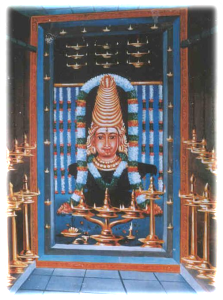 SREE KSHETRA SUCHEENDRAM IS THE MOST POWERFUL SECRET KSEHTRA OF LORD DATTATREYA. But the main attraction is the renowned shrine dedicated to Lord STHANU-MAL-AYAN (Siva, Vishnu and Brahma). Suchindrum means the place where Indra attained ‘Suchi’ i.e., purification. It is one of the few temples in the country where the Trinity, Brahma, Vishnu and Ishvara, are worshipped. The linga is in three parts. The top represents “Sthanu” name of Siva,the middle “Mal” name of Vishnu, and the base “Ayan” name of Brahma. It is believed that the Trinity. Suchindram Temple is approximately 1,300 years old. The temple construction took place over an extended period of at least six hundred years, so parts of the temple date back to the late 8th century, while others are 15th century. The earliest lithic records of Suchindram belong to the 9th Century A.D. Up until the time Kanyakumari became part of Tamil Nadu, the Suchindram Temple was under the administration of the Travancore Kings.
SREE KSHETRA SUCHEENDRAM IS THE MOST POWERFUL SECRET KSEHTRA OF LORD DATTATREYA. But the main attraction is the renowned shrine dedicated to Lord STHANU-MAL-AYAN (Siva, Vishnu and Brahma). Suchindrum means the place where Indra attained ‘Suchi’ i.e., purification. It is one of the few temples in the country where the Trinity, Brahma, Vishnu and Ishvara, are worshipped. The linga is in three parts. The top represents “Sthanu” name of Siva,the middle “Mal” name of Vishnu, and the base “Ayan” name of Brahma. It is believed that the Trinity. Suchindram Temple is approximately 1,300 years old. The temple construction took place over an extended period of at least six hundred years, so parts of the temple date back to the late 8th century, while others are 15th century. The earliest lithic records of Suchindram belong to the 9th Century A.D. Up until the time Kanyakumari became part of Tamil Nadu, the Suchindram Temple was under the administration of the Travancore Kings.
The unique feature of the Suchindrum temple is that both Saivites and Vaishnavites hold the temple in the high esteem. The shrines within, which are thirty in number. The sanctum sanctorum presenting a Shivalinga, the Thekkadam presenting the image of Lord Vishnu (human form), the Konnayadi presenting the three svayambhu lingas at the foot of an old tree (nature worship), the holy sanctum of Chitra sabha presenting a mirror (formless aspect of self-realisation) and many other smaller shrines presenting almost all the deities of Hindu.
LOCATION
It is in the state of Tamil nadu in India and is 7 kilometers from Nager Coil and 13 kms only from Kanyakumari. Though the kshetra is in Tamilnadu, it is also nearer to Trivandrum (Kerala state) which is about 3 hours journey only. The village is surrounded on all sides by paddy fields and coconut groves.
STORY BEHIND SUCHEENDRAM
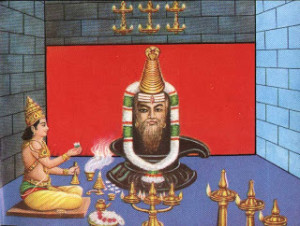 There are two stories about this kshetra, One is about Indra (King of Gods) and second one is about Lord DattatreyaOnce Indra deva was infactuated with Ahalya, wife of Gauthama rishi. One night he took the form of a cock and came to the hermitage of Gauthama and gave the clarion call to think that Gauthama was late for his bath. Gauthama arose and hurried to the river. Indra in the disguise of Gauthama, entered the hermitage and molested Ahalya. Gauthama muni saw the river yet sleeping and returned to the hermitage and find Ahalya and Indra there. He cursed Indra that his body should be covered with a thousand female genital organs and Ahalya to become a stone. Greatly afflicted by his disgrace and Indra went to Gnaanaranya and performed penance for a long time. Atlast, the grace of Lord Shiva purified him thoroughly. Indra built the shrine and the Trimurthis were represented in one linga with the name Sthaanumaalaya.
There are two stories about this kshetra, One is about Indra (King of Gods) and second one is about Lord DattatreyaOnce Indra deva was infactuated with Ahalya, wife of Gauthama rishi. One night he took the form of a cock and came to the hermitage of Gauthama and gave the clarion call to think that Gauthama was late for his bath. Gauthama arose and hurried to the river. Indra in the disguise of Gauthama, entered the hermitage and molested Ahalya. Gauthama muni saw the river yet sleeping and returned to the hermitage and find Ahalya and Indra there. He cursed Indra that his body should be covered with a thousand female genital organs and Ahalya to become a stone. Greatly afflicted by his disgrace and Indra went to Gnaanaranya and performed penance for a long time. Atlast, the grace of Lord Shiva purified him thoroughly. Indra built the shrine and the Trimurthis were represented in one linga with the name Sthaanumaalaya.
The legend is that, Indra is still doing pooja in the temple at midnight hours every night. As Indra was purified at this Gnaanaranya, it’s name was changed to SUCHI+INDRA = SUCHINDRA and the village is SUCHINDRUMSecond story goes like this : The great sage Atri and his devoted wife Anasuya had their hermitage at this gnaanaranya (now it is Suchindrum). Anasuya was renowned for her chastity. Once the sage Atri was away to participate in a Yagna, and in his absence Anasuya was doing pooja to the Paadatheertha of her Lord. She was able to bring rains from the sky by sprinkling the paadatheertha of her husband during the times of severe drought. When Goddesses Laxmi, Saraswathi and Parvathi heard throught Narada that a woman of the world had excelled them in her love towards her husband, they became jealous and decided to test the chastity of Anasuya. To satisfy the bidding of their wives, Lord Brahma, Vishnu and Maheshwara appeared in the form of old Brahmins at the hermitage of Anasuya and begged alms.
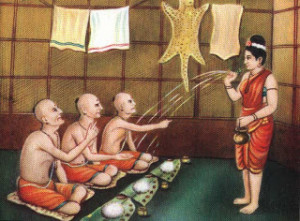
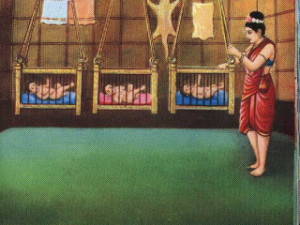
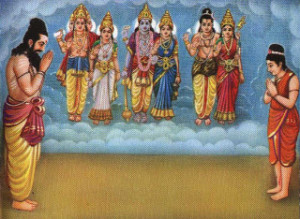
Trimoorthis asking for alms When she was about to serve them food, they told her that they had taken a vow not to eat fod served by a person who wore any dress. So, she prayed to her Lord and sprinkled the paadatheertha on the Brahmins. Immediately the old Brahmins were transformed into three suckling babies. She then undressed and fed them. She put them in a cradle and made them sleep. The long absence of the Gods instilled fear in the minds of the three Devis, and they approached Anasuya for Mangalya bhiksha. Then Anasuya sprinkled the paadatheertha on the babies and the three Gods appeared in their resplendent glory by the side of their partners. These thrimoorthis combined together and gave a birth to Atri and Anasuya in the form of Lord Dattatreya. So the pooja performed to Sthanumalyan at sucheendram is as good as worshipping Lord Dttatreya. After the Trinity left the place there sprouted three svayambulingas at the foot of a laurel tree. This laurel tree and the lingas can be seen even now at the Suchindrum temple.
IMPORTANT TEMPLES IN AND AROUND MAIN TEMPLE
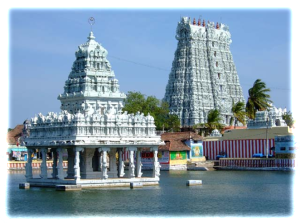 PUSHKARINI: The Pushkarini is at the outside of the temple. It is a big tank with a beautiful Mandapam in the center. It is advised to take a bath in the Pushkarni before having the darshan of Stahanumalayan/Lord Dattatreya. The legend is that, the sins of the devotees will be purified by having a bath in this Pushkarini. Swamy’s Kalyana and Theppotsava will always be performed in the Mandapam of the Pushkarini.
PUSHKARINI: The Pushkarini is at the outside of the temple. It is a big tank with a beautiful Mandapam in the center. It is advised to take a bath in the Pushkarni before having the darshan of Stahanumalayan/Lord Dattatreya. The legend is that, the sins of the devotees will be purified by having a bath in this Pushkarini. Swamy’s Kalyana and Theppotsava will always be performed in the Mandapam of the Pushkarini.
Tower(Gopura) of the temple:The tourists will always attracted by the charm and grandeur of the lofty Gopuram at Suchindrum temple. The Gopuram is a marvel of construction, standing majestically 134 feet height with 7 steps. Even from a distance the tower of the temple, framed by the coconut trees and the sky as a backdrop, makes a fascinating picture.
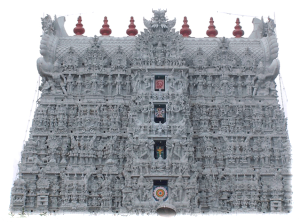 Smiling Subrahmanyeshwara: The Lord Subrahmanya in this temple is appearing with full smiling face. He is in the shakti sampanna form.
Smiling Subrahmanyeshwara: The Lord Subrahmanya in this temple is appearing with full smiling face. He is in the shakti sampanna form.
Vigneshwari: Lord Vinayaka is appearing as a part of female and remaining as a male form. This vinayaka is a combination of male and female form and hence this Vigneshwar is terming as VIGNESHWARI. This Ganeshaani murti in sukhasana pose at Suchindram is one of only a few, the others being at a 10th century temple dedicated to 64 yoginis in Bheraghat, near Jabalpur, and one at the Tanumalaya Swami Temple in Suchindrum, Kerala. In Tibet, this female form of Ganesh is worshiped as Gajanani. 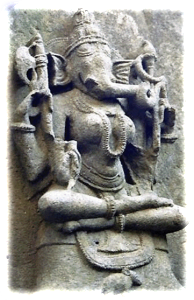 Viswaroopa Hanuman:Vishwaroopa Hanuman-Jai Hanuman It is stunned to see the huge image of Lord Hanuman the embodiment of devotion and humility, depicting his Vishwaroopa Darshan given to Sitha at the Ashoka forest, as described in the Sundarakanda of Ramayana. It is about 18 ft height and is remarkable for its grandeur and massiveness. As we approach the image we feel how insignificant we are and stand transfixed. This figure is placed diametrically opposite to the figures of Lord Rama and Sitha. The full tail of Lord Hanuman is in the full upward direction.. As per Shaastra, it is very powerful to perform puja to tail of Lord Hanuman. In this temple, it is a practice to apply butter to the edge of the tail to give cooling effect to Lord Hanuman to get a relief from the burning position of the tail. Sides of vigraha two ladders are there, the priest will go to the top of the murthy and apply the butter to the tail. They will give the applied butter as a prasada and if we apply this butter to the backside of our children, there won’t be any graha doshas to the kids.
Viswaroopa Hanuman:Vishwaroopa Hanuman-Jai Hanuman It is stunned to see the huge image of Lord Hanuman the embodiment of devotion and humility, depicting his Vishwaroopa Darshan given to Sitha at the Ashoka forest, as described in the Sundarakanda of Ramayana. It is about 18 ft height and is remarkable for its grandeur and massiveness. As we approach the image we feel how insignificant we are and stand transfixed. This figure is placed diametrically opposite to the figures of Lord Rama and Sitha. The full tail of Lord Hanuman is in the full upward direction.. As per Shaastra, it is very powerful to perform puja to tail of Lord Hanuman. In this temple, it is a practice to apply butter to the edge of the tail to give cooling effect to Lord Hanuman to get a relief from the burning position of the tail. Sides of vigraha two ladders are there, the priest will go to the top of the murthy and apply the butter to the tail. They will give the applied butter as a prasada and if we apply this butter to the backside of our children, there won’t be any graha doshas to the kids.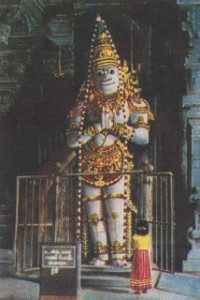
NAVAPAASHAANA BALAJI: Lord Venkateshwara is appearing with silver kavacha and the stone used for the lord Balaji moorthi is Navapaashana shila. We can find this type of shila in Palani (Lord subrahmanya moola virat) and in very few temples. Whoever takes the abhisheka theertha of this navapaashana shila, then deceases if any of the concerned person will be cured within few days.
Shankhu powder Nandeeshwar (huge white bull):In this temple, we can find very big Nandi (vahana of Lord Shiva) . It is 9 ft height and 13 ft width. It is a gigantic bull and is terming as Makkalai which is facing Lord Sthanumalaya. The full Nandi was made with full shankhu powder only.
Jagadguru Adishankara: There is a legend that, Jagadguru Aadishankara obtained the “PRANAVA” mantropadesha from Lord Shiva and had seen the Shiva thaandava darshan of Lord Shiva in this Suchendrum.
Lord Sthanumalaya: The Sanctum Sanctorum of Lord Sthanumalaya, is fully illuminated by oil lamps. Crossing the Nandi, we have the darshan of Lord Sthanumalaya in the form of Linga at about 1.25 ft hight. Except at the time of Abhisheka (4.00 a.m.), the linga is fully covered by a golden kavacha. The charming serenity of the spot and the devotion is superb. The main hall of this garbhalaya appearance is very great and akhanda jyothi is continuously illuminating in this hall.
Sapthaswara piller/ring piller: It is true that, we can hear the music from the rock pillars of the temple. By entering into the Alankara mantapa, we can see four pillers each carved out of a s ingle stne. Two of them contain 33 smaller pillars. These are the famous Musical pillars and one can hear the most melodious musical saptaswara tunes emanate from then when tapped. It is real and another pillar will give the sound of a ring. The aarohan and avarohana styles can be easily experienced as per your tapping style of the pillar. We can also see a pillar in the temple premises, in which if we introduced a piece of wire through the right nostril of the statue, it will comes out of the left ear and when it is made to pass through the right ear comes out of the left. It is a wonder and can be seen in the temple.
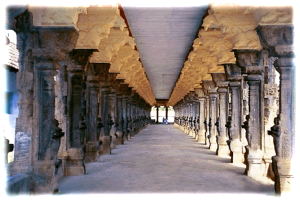
Lord Dattatreya: We can have the darshan of Lord Dattatreya in the hollow at the foot of the tree, where three lingas sprout one above the other. This can be seen only at the time of abhisheka in the morning (4.00 a.m.) and they are usually hidden in the a golden kavacha in the day hours.The branches of the Konnai (laurel) tree are also seen at the top of the shrine. It is an irrefutable fact that the tree is very old and parts of the tree were sent to London and Kalkatta and were examined by experts who concluded that the tree would have flourished atleast 2000 years ago. There is an evidence that, almost all the shrines in the temple are came into existence before the first quarter of the 12th century.
It is confirmed that Indra is regulary visiting this temple in the night hours and performing puja to Sthanumalaya. Even priests of the temple are confirming that the location of the puja samagri in the Garbhalaya are changing by the next day morning everyday means, Indra is coming and performing puja to Trinity God.It is advised to every one to visit this Kshetra atleast once in their life time and have the blessings of Trimoorthi roopa.
If an unmarried person visits Kanyakumari devi and Suchidrum Trimoorhty in a single trip, their marriage will be settled at the earliest. Thus this sacred shrine leaves indelible impressions in the minds of the visitors and no tourist fails to carry sweet memories on his exit from this shrine.
FESTIVALS PERFORMED
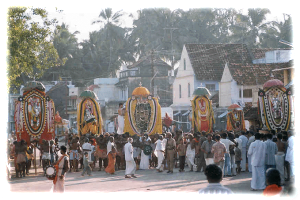 There are two important festivals, one in Markazhi (December/January) and the other in Chiththirai (April/May). During the Markazhi festival, on the 9th day the deities are taken out in procession around the streets on three festival cars.
There are two important festivals, one in Markazhi (December/January) and the other in Chiththirai (April/May). During the Markazhi festival, on the 9th day the deities are taken out in procession around the streets on three festival cars.
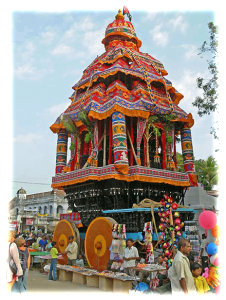
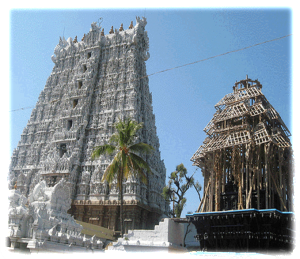
The chariot is made of wood and is carved with beautifully detailed sculptures, many of which feature the pastimes of Krishna and Rama leela. Each year, the upper portion of the car is remade with fresh poles and fabrics, and taken out on procession.
While Their Lordships’ original temple chariot was destroyed during the invasion of Khan Chanda Saheb, many devotees sacrificed their lives in protecting the remaining chariots, thus forcing the invaders to retreat. Afterwards, the Devi (Amman) car was made the major chariot. Each year it is accompanied by the chariots of Ganesha and Swamy, and each of the chariots bears one member of the Trimurtis.
DAILY POOJAS
Abhishekam is being performed thrice a day in this temple. Ad midst regular poojas, there are special poojas performed to the God and Goddesses.
- Abisekam for Moola lingam at 4.15 a.m
- Abisekam for Thanumalayan Shrine at 4.45 a.m
- Daily festival Pooja at 5.30 a.m
- Tharai Abisekam at 6.30 a.m
- Mistanga Pooja at 7.00 a.m
- Uchikkala Poojai, Deepa Aradhanai at 11.00 a.m
- Deepa Aradhanai, Ahala Poojai & Arthajama poojai at 6.30 p.m
ACCOMODATION
Suchendrum is a small village and hence lodging facilities are available at nominal cost with ordinary facilities. Some choultries are also available for staying purpose. It is strongly recommended to have at least one night sleep in the kshetra and perform Abhisheka in the early morning at about 4.00 a.m.
HOW TO REACH
| BY TRAIN |
From Chennai:There are direct trains to Nagercoil (Nagercoil express)/Kanyakumar i/Trivandrum and from there one can reach Suchendrum very easily. If any one reaches Madhurai (Goddess Meenakshi), then it is convenient to reach Suchendrum by Travels buses maintaining by Private operators or by Tamilnadu tourism or by Tamilnadu State Road Transport. It is around 15 to 16 hours journey From Hyderabad: Direct train is available to Kanyakumari or one can reach Chennai to catch a connected train as per our convenience. From Vijayawada: Direct trains are available to Kanyakumari/ Nagercoil/ Trivandrum and weekly special trains are also available. It is around 24 to 26 hours journey from Vijayawada to Kanyakumari. City buses/private buses are available to reach Suchendrum. FROM PUNE/MUMBAI/ HOWRAH/BANGALORE: Direct trains are available to reach Kanyakumari/ Nagercoil and weekly special express is also available to reach Kanyakumari. |
| BY AIR |
Regular flights are available from Bangalore, Hyderabad, Rajkot, Pune, Mumbai, Kalkatta to Trivandrum and one can take bus/train/taxi to reach Suchendrum. Jet airways/Airdeccan etc., services are available for Trivandrum. |
| BY BUS | It takes 26-28 hours from Hyderabad. So it is advised to reach Nagercoil or Kanyakumari by train and travel by bus to Suchindram. |
WHOM TO CONTACT
Arulmigu Thanumalaya Swamy Thirukkoil
PH 04652- 241421
Hindu Religious and Charitable Endowment
Ph 04652 – 241270
DATTAM BHAJE || GURU DATTAM BHAJE||
ATRI ANASUYA PUTRA|| DATTAM BHAJE||




